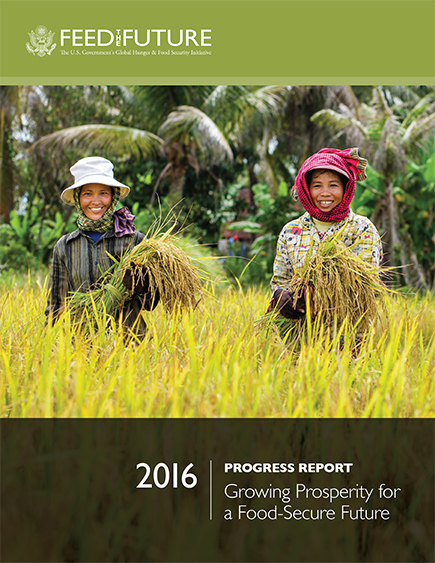For Immediate Release
WASHINGTON -- Today as leaders and experts from around the world gather in Des Moines, Iowa, for the annual World Food Prize, the U.S. Agency for International Development announced impressive progress toward achieving the goals of Feed the Future, the U.S. Government's global hunger and food security initiative. The initiative's annual progress report notes that since the start of the initiative, poverty has dropped up to 36 percent in many areas where Feed the Future works and child stunting -- a measure of malnutrition -- has dropped by as much as 40 percent.
2016 Feed the Future Progress Report ![]() (pdf - 12.7MB)
(pdf - 12.7MB)
"Results like these are possible because of the coordinated approach the U.S. Government and its partners have taken to help countries transform their food and agriculture sectors," said Feed the Future Deputy Coordinator Beth Dunford, who announced positive gains during her remarks at the World Food Prize's Borlaug Dialogue. "The Feed the Future model of development is proving itself in country after country, helping millions of smallholder food producers boost their incomes, connect to markets and grow a better future for themselves and their countries."
Created as one of the first major foreign policy acts of the Obama Administration and building on Bush Administration resources, Feed the Future has pioneered a comprehensive approach to ending global hunger that draws on partnerships across sectors, promotes country leadership, and focuses on achieving results and is contributing to reductions in poverty and stunting in the areas where it works. This successful approach is now codified in the Global Food Security Act, which was enacted in July with bicameral, bipartisan Congressional support. Last week, the 11 U.S. Government agencies and departments that have worked together to support Feed the Future delivered to Congress the first milestone in fulfillment of the legislation: a government-wide, five-year strategy on global food security.
"We're thrilled to share this new strategy for the next phase of progress in global food security," said Dr. Dunford. "The Act and corresponding strategy build on our progress to date and send a clear message that the United States is committed to helping end global hunger, poverty, and malnutrition. The results we've achieved through Feed the Future and our continued effort to help communities lift themselves up is something every American can be proud of."
The new U.S. Global Food Security Strategy draws on the experiences and tools of 11 U.S. Government federal agencies and departments that have worked together under Feed the Future since 2010. It charts how each will contribute to global food security efforts over the next five years to improve coordination, monitoring, and evaluation of impact toward this commitment. Agency and department-specific implementation plans in the strategy include financial resources that each agency and department intend to commit toward this endeavor.








Comment
Make a general inquiry or suggest an improvement.